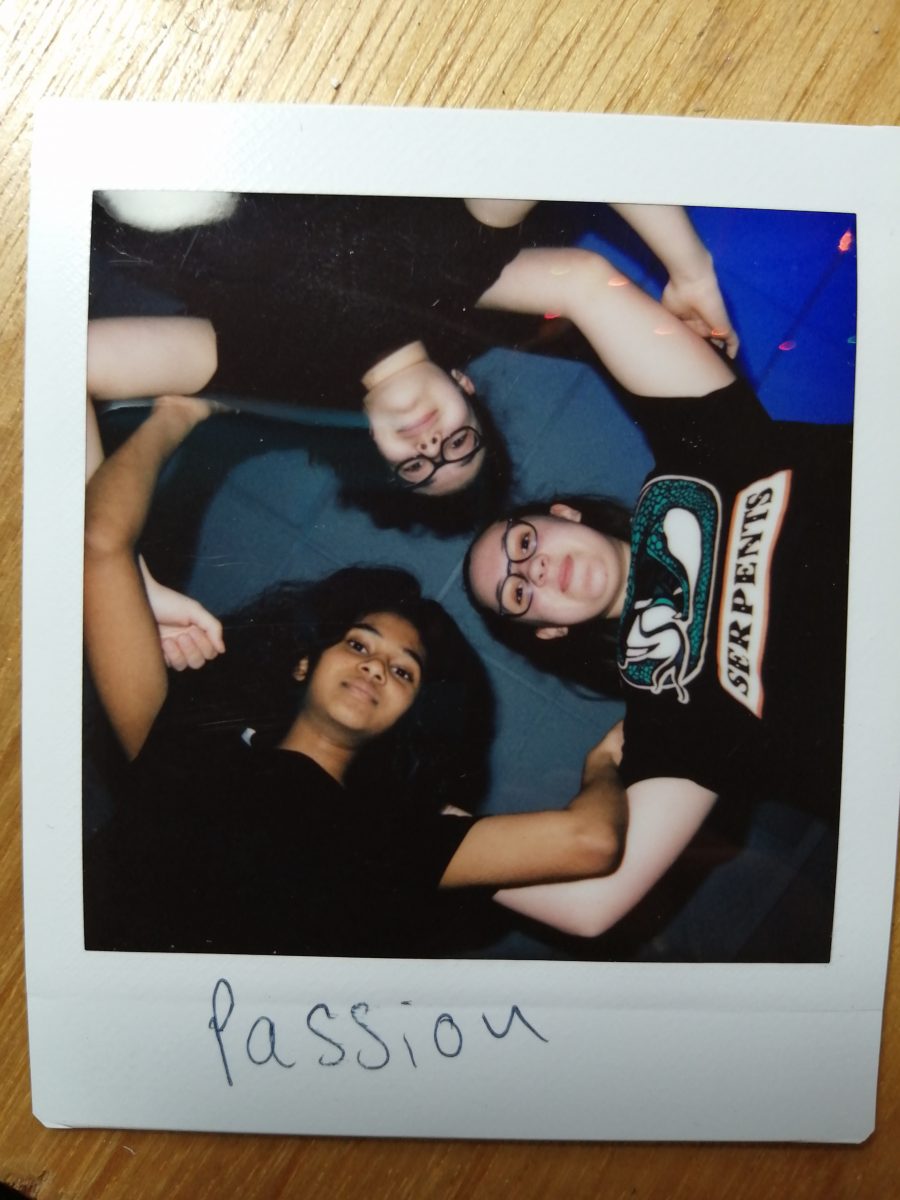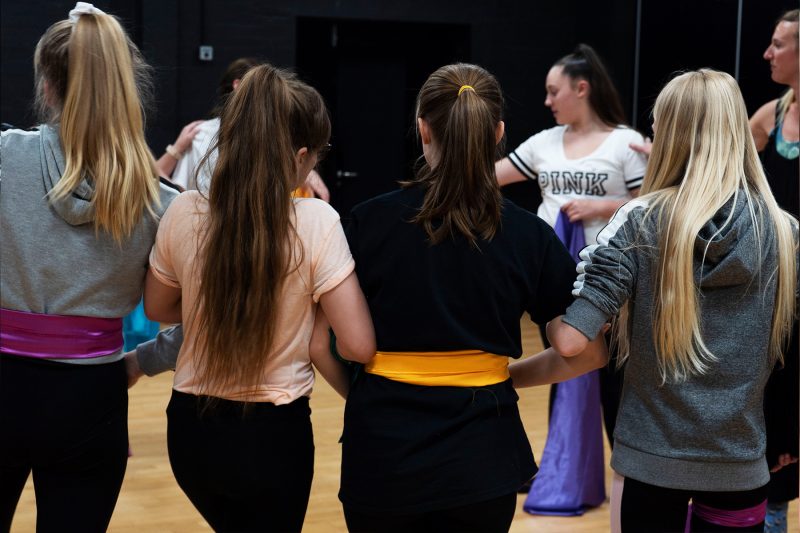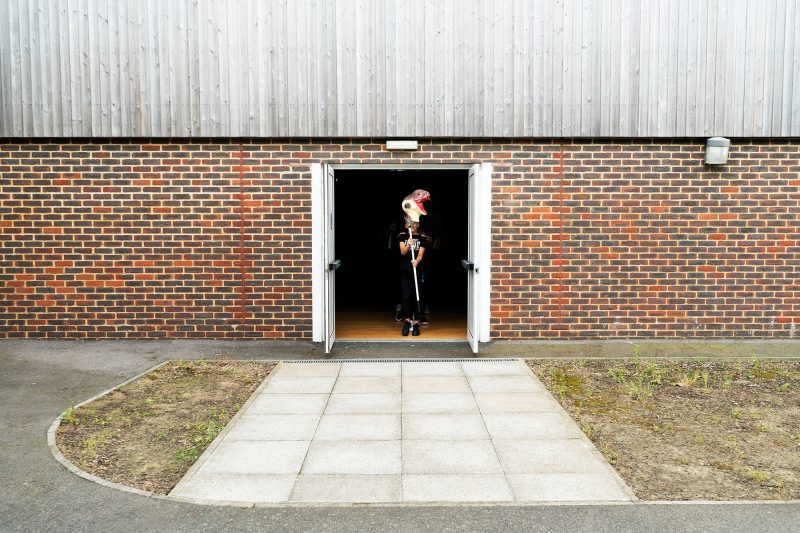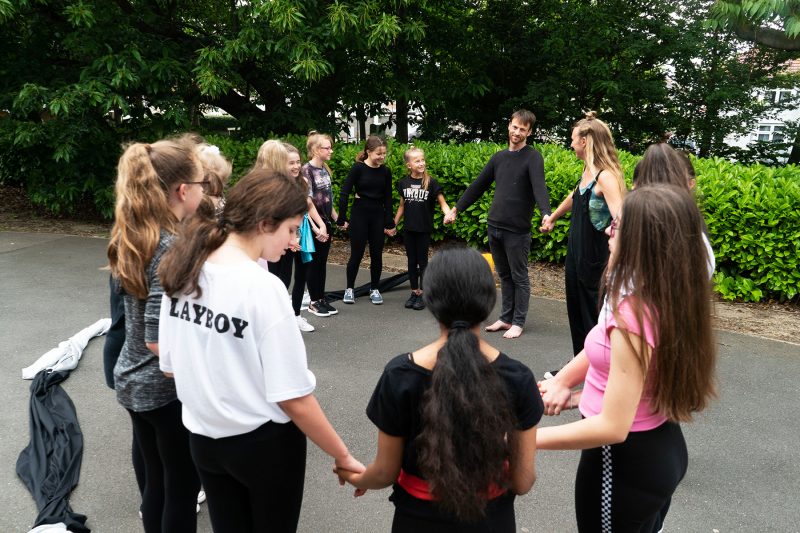
Since late 2018, artist duo Webb-Ellis have been working with secondary school students at Northfleet Technology College and Northfleet School for Girls, collectively re-imagining ways of being and learning together through the methods of philosophical enquiry, radical listening, dance, movement, and film making.
Through day-long sessions each term at Northfleet School for Girls, they have created immersive environments to engage a group of seventeen 13-year-olds in exploring ideas of the future, the body, and our human place within a fast-changing world.
At Northfleet Technology College they have held weekly hour-long sessions with a class of 6th form students, gradually building a community of philosophical enquiry structured around the concerns and interests of the students. Discussions have covered topics as wide-ranging as happiness, fate, money and the class divide, the new space race, gender, bodily rights and abortion, privilege, pornography and what we mean by ‘reality’.
The artists envision these workshops as a form of living research, and the ideas and material created in collaboration with students will build into a new film installation.
To inform their approach to the sessions, Webb-Ellis have been speaking regularly with Grace Lockrobin, a philosophy practitioner, academic, writer, trainer and consultant who has spent all of her working life exploring the good philosophy can do in the educational lives of children and adults.
Grace is also the founder of Thinking Space – an education company dedicated to the business of bringing people into philosophical conversation with one another. She is a Teaching Fellow in Philosophy at the University of Leeds where she runs ‘Leeds Philosophy Exchange’, and is also studying for a doctorate in Philosophy of Education at UCL Institute of Education.
Below is the transcript of a conversation which took place on a rainy morning just before Christmas 2019 at Grace’s home in Sheffield.
Caitlin Webb-Ellis: When you say the word philosophy, it’s like there’s this conjured up image of a philosopher and an idea about the type of people who can ‘do’ philosophy. We’re interested in turning that idea on its head, making work about the bigger questions, the things that matter, and working with people to find out what those questions are. I think that’s where philosophical enquiry allows us ways in, to engaging with people on a bit of a different level or in a slightly altered relationship.
Grace Lockrobin: I think there are massive crossovers with forms of artistic practice and forms of public philosophy. As artists you’re meaning-makers, seeking out and creating meaning, making judgements about what really matters. Community philosophy, as I see it, is about working out what matters to groups of people, groups of children, to individuals.
One of the key ways that community philosophy – where people are talking and thinking together – differs from the sort of philosophy that’s happening in universities, is that it doesn’t start with a canon. There is this massive canon of ideas comprising the work of major philosophers who have been acknowledged at being really good at what they do and I think it’s really good to engage with those texts at some point, but that’s not where community philosophy begins. It begins with trying to create and stimulate opportunities for people to ask: ‘What do I think is really, really important?’ ‘What are the important concepts and relationships between ideas that I don’t get a chance to investigate ordinarily?’

There are different ways of investigating these ideas, you can investigate them scientifically, you can investigate them artistically, and you can investigate them philosophically. Artistic and philosophical ways of exploring ideas are complementary, one of the reasons for this being that they’re typically open-ended. One of the ways philosophy can help is that it is essentially linguistic, it is about trying to capture those thoughts and feelings and relationships and connections in words. So if your practice is not primarily linguistic it allows for some kind of translation between the forms. Not that you can or should aim to offer a perfect translation but it can be a nice relationship between the two ways of working.
CWE: Definitely, I think that’s one of the things we’re interested in. What we’re doing in the schools has that linguistic foundation and then from that, we’re taking it into physical movement, returning the thoughts to the body and actively seeking the place where words disappear. What’s interesting is then coming back full circle to try and find language again, the ideas are altered and this cycle could go on indefinitely.
GL: Not everything that humans experience or think is important can be captured in words, so when you explore ideas that come out of Science Fiction, that might conjure up loads of associations and emotions and some of those might essentially be best communicated in non-linguistic ways so it’s that lovely yin-yang. It’s not a direct translation from one to the other, but it’s bolstering it with other ways of communicating.
But also one of the things I think I like about philosophy and artistic practices working together is that together they can challenge (or maybe reimagine) a common and problematic folk understanding of art that many people seem to have.
This is an understanding that says: ‘Art has a meaning, and that meaning was in the head of the artist first’. If you interrogate the artwork, somehow you’ll get to the meaning that was in the artist’s head and it’ll be something propositional like: ‘This means love is brilliant or war is bad’. Yet the process of philosophising about artistic meaning, reveals that you and I play a role in meaning-making too. The artwork can actually be a springboard for you to work out what you think love or war means: the artists don’t have the final word on that. Also, the meaning you might create – or extract – from the artwork, is more than the sum of its parts. Meaning is a big, ongoing conversation that everyone has a stake in.
Artists might be comfortable with that, but when you’re doing exploratory work with the public, it’s a lot to get your head around. Like, hang on a second, so you’re saying I could create a meaning that you artists didn’t intend? Well in that case, haven’t I just made it up then? Isn’t this all smoke and mirrors then, this art? Is it just a load of people making stuff up? Philosophical processes can help people to understand meaning making and feel ok with it. They can feel more connected to art as a result.
So I think the way that you’re working seems really natural, it makes sense to me.
Andrew Webb-Ellis: We’ve been super inspired growing with the groups of students, and watching them start to volunteer their voices a lot more.

GL: How did they respond to the stimulus that you chose? Does it feel like you chose something that resonated? Did it ignite their imaginations as it were?
CWE: It feels like we’ve been going through quite different processes with the two school groups. With the one hour per week at the boys’ school, we’ve been working with them as a group to introduce them to these ways of thinking, and there were quite a few barriers to address at first to do with confidence and the fact that they hadn’t been together as a group before. So we’ve tried to be very intuitive, planning sessions based on what they tell us and say in the discussions, trying to weave a thread through it all without imposing any particular themes, listening to their curiosity. We often use movement and music with them more as a way of changing the state they enter the classroom in. It has been amazing to see them open up to it.
With the girls’ school, we took a really different approach. Having a full day together meant we could work with creating that sci-fi world, using lighting and projection, costume and props to try and alter the space as much as possible from the school environment. No uniform, different rules.
GL: More immersive for them than the boys, because of the format as well as the circumstances of having to do lots of work on building their confidence.
AWE: Yeah, with the girls we’ll be constantly switching between movement and thinking, weaving the two together.
CWE: One of the things that has come up a lot, one of the challenges that we’ve felt in working in schools, is the perceived neutrality of what goes on in schools. And realising it’s a very particular system with ingrained ways of being in that space which are really hard to shake off – and how that actually goes deeper into the ways that they allow themselves to think or speak or physically move… and how we can try and explore other possibilities.
GL: I see that. The way that just the place, those four walls, can make people expect to behave a certain way. So with the girls, you have explored ways to take them out of school even though they’re physically still there, but with the time and space constraints at the boys’ school you’re still marching to the beat of the bell, which is massively difficult isn’t it?
AWE: We’d at least try and get the boys to take their ties off, symbolically, and to make it easier for them to move. They are at an age where they have many pressures and exams to pass, so finding ways to change gear into our sessions, and to allow it to not have a set goal or qualification attached is definitely a challenge for them, and us, to deal with.

GL: There’s an amazing philosophical enquiry in that. In my work in schools, ‘why are we here, what the hell is this for’ is my favourite set of questions because for those students to have a good life, it would be good for them to reach some sort of comfort with not knowing where things are going because that’s the nature of the human condition. No matter what kind of careers they eventually have, that’s not going to go away, that question of ‘what is this all for and where is it going?’.
I’m interested in where you see the crossover with the movement and dialogue.
CWE: All the conversations we have are based in this kind of method of philosophical enquiry, so if we’ve done a sensory exercise moving and listening with blindfolds, for example, we always gather and share feelings, but that will expand in a more philosophical direction. And a stimulus that might start an enquiry will also be a stimulus for movement – so they’re responding with their bodies and then their thinking.
GL: Exactly how that works would be fascinating to read because it’s really mysterious. One of the things I’m interested in is whether there is a drive towards being literal? Like they’re talking about conflict and miming conflict in dance, or are they managing to be quite expressive? Not that I’m saying that’s better, but how abstract or how literal are they being?
CWE: There is a tension there because we really resist that literal interpretation – everyone knows how to mime being scared. We try to provide props like coloured silks or more ambiguous objects that can be used symbolically. But we mainly put the focus on what is going on internally rather than what it looks like on the outside. We turn all the mirrors around and use a lot of coloured light and video projection to change the atmosphere and expectations of movement and to reduce the anxiety around moving in ‘weird’ ways.
AWE: It’s usually about getting them to move from a sense of their own physical experience, rather than pretending or appearing to be something. Though that can be interesting too.
CWE: In the sessions, we’ll sometimes take words or concepts that come out of a philosophical enquiry and then use those as a starting point for them to make these slow-moving sculptures with their bodies. Some students will be very literal with that, but other times it’s not literal at all and very interesting what that looks like, and for the others observing to consider how bodies can allow us to visualize a concept that’s just emerged through language.
GL: So they’ve talked about something and then you’ve found these non-literal ways of exploring it. What I’m interested in is, when they come back and talk about it do they try and make it literal again? Are these linguistic/non-linguistic approaches working together or are they fighting?
CWE: There are moments where it seems to come full circle because there’s always this pull to want to concretize it or find the answer. But it’s always changed, by the time it has gone from an idea, through movement, and back to the idea, it is always transformed. And to look at where we came from and where we ended up is interesting in itself. In our work, in general, we’re interested in the gaps between things, and what happens in the uneasy places between one thing and another. It is tricky in the schools because we like the in-between, but that can be uncomfortable, especially within that system.
GL: Have you thought about experimenting with what it does to your artistic process if you let that literal way of moving and style of dance run and see what it does to your work? Because it’s often about them playing with their discomfort but what about you playing with your discomfort?
CWE: We have had times in the sessions where we have decided to just let it out of the bag, let them move in the ways that they seem drawn to. They actually carried on with the philosophical concepts we had been working with and I think elements of it were beneficial. We’ve definitely talked a lot about what it would mean to follow their pleasure, surrender a bit to what they want to do. It’s something we will definitely bring to our collaborator, the choreographer Lucy Suggate; I think there are some interesting conversations to be had there!

GL: Do you think that the fact that this process must culminate in a film – and of course you’ll have a sense of what kind of look and feel your films have – somewhere in there you’re thinking what would happen if we followed that kind of dancing, what would that look like and would it work for the film?
CWE: That’s a really interesting tension in the idea of making art from a process like this. It’s slippery! It’s a question of how much freedom you can allow the process when you know there is an outcome attached. But we are really excited by the unknown, and actively cultivate situations for unplanned moments to arise which shape the work. So we seem to be surrendering to it so far.
GL: I think there are some foundational questions to be asked, like ‘What does working with young people bring to the artistic process?’, ‘What has this significant dialogue element brought to the process, and what has it taken away?’, ‘In what ways might we be able to see the fingerprints of the process in the film?’
CWE: I think one of our main motivations for working like this is to connect deeply with all sorts of other people and allow the questions and concerns of our work to expand out and have a life beyond the film we make. The moments we share in these kinds of interactions give particular insights into ideas about being human which we wouldn’t have alone and I hope these tiny moments can somehow spiral outwards to form the foundation of any film or tangible outcome that we end up making.
AWE: We’re thinking and talking a lot about the future in this project, and it’s interesting to think that the young people might be able to think thoughts we can’t think, or haven’t thought, expanding the different ways we can think about the subject. They might be able to tap into ideas or ways of thinking that are closed off to us and could be transmitted through the work we make. Our way of working is very exploratory, and we feel our way through things. The images that end up coming together to make our films often come up in unexpected ways and might seem wide-ranging or loosely connected, but they’re always joined together by the process that we’ve been through.
GL: One of the things, if you’re interested in the future, is getting young people to be those conductors or transmitters or whatever… there’s something inherently forward-looking about young people, they started out on this planet later than you, they’re exposed to a whole set of influences that you’re not, if everything goes the way it should be they will be around when you’re not. So there’s a sense that they are ahead in time. It’s nice, that idea that young people might have thoughts that you wouldn’t have or couldn’t have.
And also thinking about Philosophy for Children pedagogy, there’s something deeply respectful to thinking about young people’s ideas in that way. It’s a nice exemplification of the ethos of P4C [Philosophy for Children].
CWE: We sometimes wonder how this process is going to contribute to or be made visible in the work we make, but have come to understand that even the small or special moments experienced in the sessions; the one thing someone said, or the shared experience of presence and focus that fell on the group in a dance, are all equally part of the creative work, not just a means to making a film.
AWE: I think it’s the idea that the film is growing straight out of that work with the young people, that’s where we’re at right now anyway, planting seeds.
Find out more about Webb-Ellis’ project We chose the earth.